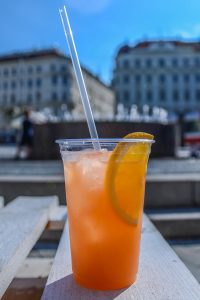All fields are required
Posted in Food Policy,Our Blog on March 12, 2024

Image by Rudy and Peter Skitterians from Pixabay
A U.S. Food and Drug Administration (FDA) proposal to ban an orange soda ingredient in November may finally go through. This move would outlaw the ingredient already banned in the state of California (an effective date in 2027) and several other countries, including India, Japan, and nations of the European Union.
What is the controversial orange soda ingredient? Brominated Vegetable Oil, or BVO.
Oil?
In soda?
You heard that right.
This substance has been used as an emulsifying agent in citrus flavored sodas since the 1930’s to evenly distribute citrus flavoring agents in the beverage.
BVO is made by attaching a dozen bromine atoms to a triglyceride, creating a dense oil.
Why?
This structure moves evenly throughout a liquid, preventing the flavoring from sinking to the bottom. This means that the citrus flavor remains consistent throughout the beverage without needing to regularly mix it. This ensures every sip is as good as the one before it.
If this orange soda ingredient has been used for decades, why is its use now being questioned?
Information is key! The more you know about something, the harder it is to ignore the negative effects of using it.
This regulatory move comes in response to recent toxicology studies showing the dangers of this orange soda ingredient.
“The proposed action is an example of how the agency monitors emerging evidence and, as needed, conducts scientific research to investigate safety related questions, and takes regulatory action when the science does not support the continued safe use of additives in foods.” — James Jones, FDA Deputy Commissioner for Human Foods
Studies show that this compound becomes dangerous in the way it slowly builds up in our fat tissues.
Combined with a triglyceride, the bromine gets incorporated into fat cells, which eventually build up in the body.
Why is that a big deal?
In addition to most people not expecting their sodas to come with triglycerides, that bromine molecule can cause havoc on the human endocrine system.
Bromine in the system competes for iodine inside the thyroid. This depletes the organ of iodine, a key component of hormone production essential to the body.
The result?
Hypothyroidism or an underactive thyroid.
Hypothyroidism can cause severe tiredness, feeling cold, weight gain, and goiter (enlarged thyroid).
In addition to the effects on the thyroid, this orange soda ingredient has also been linked to heart and behavioral problems in animal studies from the UK dating all the way back to the 1970’s.
Over time, the U.S. government has increased regulation activities on this additive.
In the late 1950’s, the FDA created a category known as GRAS or “generally recognized as safe.” Items in this category have either been appropriately tested, or like the orange soda ingredient, commonly used prior to 1958 without the overt appearance as harmful.
This standing evolved the following decade as more questions were brought about regarding the safety of the chemical. Not enough information was available, according to the agency, to outright ban its use at the time. The agency eventually overturned the open-ended GRAS classification for BVO and replaced it with a concentration limit.
Since then, current regulations have limited BVO exclusively to citrus flavored drinks and capped at 15 parts per million.
However, studies show that even at these low levels, this stance may not be enough. Hence, the proposed ban would eliminate its use altogether.
The push behind the ban came around 2014 when more research continued to support the hypothesis of harmful effects BVO causes in animal studies.
The FDA began working on methods to accurately measure BVO in beverages in an effort to police these new limits. However, a ban is what the agency and the interested public seeks.
While a ban would ensure it isn’t used in products distributed throughout the United States, alternative ingredients have been formulated and incorporated into most mainstream beverage producers. Data indicates that about 10% of the products on the market still contain the additive.
“Over the years many beverage makers reformulated their products to replace BVO with an alternative ingredient, and today, few beverages in the US contain BVO,” says Jones.
BVO is not the only option.
Alternatives to the orange soda ingredient already exist and are currently used in many citrus beverages.
Three approved food additives already classified as GRAS are BVO alternatives:
Just as other countries have eliminated the ingredient in their beverages, other mainstream drink makers in the United States have begun phasing out the offending chemical.
PepsiCo and Coca-Cola Co. have spent the decade phasing out the use of BVO.
The original announcement for the proposal ban came in November 2023. This announcement indicated that the agency was reviewing regulations that authorize the use of certain food additives.
According to the announcement, the agency proposes a Human Foods Program (HFP) that will enhance the review of food chemical safety. This Program will create a special department dubbed the Office of Food Chemical Safety, Dietary Supplements, and Innovation that should streamline the process for evaluating chemicals in the food supply.
This answer may come sooner than that though, due to recent toxicology studies in collaboration with the National Institute of Health (NIH). These findings “have now given us conclusive evidence to support our proposal to remove the FDA’s food additive authorization for BVO,” according to the announcement.
So, a ban could happen sooner rather than later.
If you’d like to know more about food safety in the news, like FDA Finally Proposes to Ban Orange Soda Ingredient, check out the Make Food Safe Blog. We regularly update trending topics, foodborne infections in the news, recalls, and more! Stay tuned for quality information to help keep your family safe, while The Lange Law Firm, PLLC strives to Make Food Safe!
By: Heather Van Tassell (contributing writer, non-lawyer)